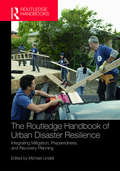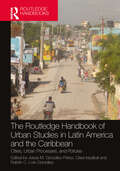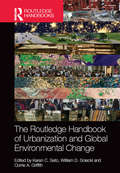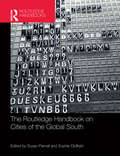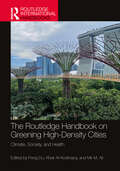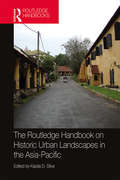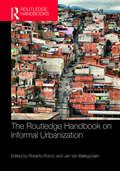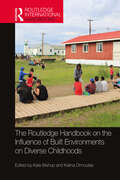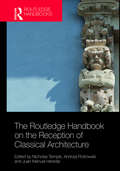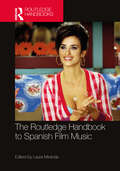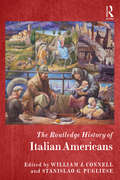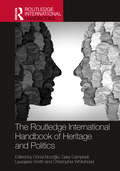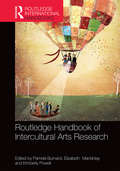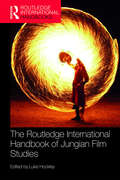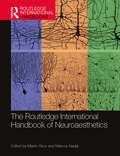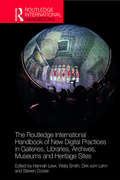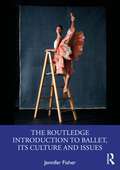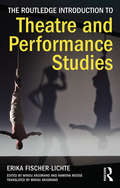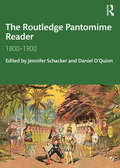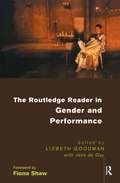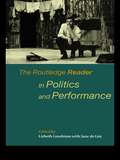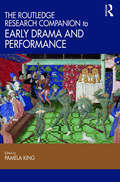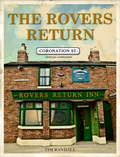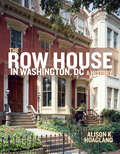- Table View
- List View
The Routledge Handbook of Urban Disaster Resilience: Integrating Mitigation, Preparedness, and Recovery Planning
by Michael K. LindellThe Routledge Handbook of Urban Disaster Resilience emphasizes the intersection of urban planning and hazard mitigation as critical for community resilience, considering the interaction of social, environmental, and physical systems with disasters. The Handbook introduces and discusses the phases of disaster – mitigation, preparedness/response, and recovery – as well as each of the federal, state, and local players that address these phases from a planning and policy perspective. Part I provides an overview of hazard vulnerability that begins with an explanation of what it means to be vulnerable to hazards, especially for socially vulnerable population segments. Part II discusses the politics of hazard mitigation; the failures of smart growth placed in hazardous areas; the wide range of land development policies and their associated risk; the connection between hazards and climate adaptation; and the role of structural and non-structural mitigation in planning for disasters. Part III covers emergency preparedness and response planning, the unmet needs people experience and community service planning; evacuation planning; and increasing community capacity and emergency response in developing countries. Part IV addresses recovery from and adaption to disasters, with topics such as the National Disaster Recovery Framework, long-term housing recovery; population displacement; business recovery; and designs in disasters. Finally, Part V demonstrates how disaster research is interpreted in practice – how to incorporate mitigation into the comprehensive planning process; how states respond to recovery; how cities undertake recovery planning; and how to effectively engage the whole community in disaster planning. The Routledge Handbook of Urban Disaster Resilience offers the most authoritative and comprehensive coverage of cutting-edge research at the intersection of urban planning and disasters from a U.S. perspective. This book serves as an invaluable guide for undergraduate and postgraduate students, future professionals, and practitioners interested in urban planning, sustainability, development response planning, emergency planning, recovery planning, hazard mitigation planning, land use planning, housing and community development as well as urban sociology, sociology of the community, public administration, homeland security, climate change, and related fields.
The Routledge Handbook of Urban Studies in Latin America and the Caribbean: Cities, Urban Processes, and Policies
by Rubén C. Lois-González Clara Irazábal Jesús M. González-PérezThis handbook presents the great contemporary challenges facing cities and urban spaces in Latin America and the Caribbean. The content of this multidisciplinary book is organized into four large sections focusing on the histories and trajectories of urban spatial development, inequality and displacement of urban populations, contemporary debates on urban policies, and the future of the city in this region. Scholars of diverse origins and specializations analyze Latin American and Caribbean cities showing that, despite their diversity, they share many characteristics and challenges and that there is value in systematizing this knowledge to both understand and explain them better and to promote increasing equity and sustainability. The contributions in this handbook enhance the theoretical, empirical and methodological study of urbanization processes and urban policies of Latin America and the Caribbean in a global context, making it an important reference for scholars across the world. The book is designed to meet the interdisciplinary study and consultation needs of undergraduate and graduate students of architecture, urban design, urban planning, sociology, anthropology, political science, public administration, and more.
The Routledge Handbook of Urbanization and Global Environmental Change (Routledge International Handbooks)
by William D. Solecki Karen C. Seto Corrie A. GriffithThis volume provides a comprehensive overview of the interactions and feedbacks between urbanization and global environmental change. A key focus is the examination of how urbanization influences global environmental change, and how global environmental change in turn influences urbanization processes. It has four thematic foci: Theme 1 addresses the pathways through which urbanization drives global environmental change. Theme 2 addresses the pathways through which global environmental change affects the urban system. Theme 3 addresses the interactions and responses within the urban system in response to global environmental change. Theme 4 centers on critical emerging research.
The Routledge Handbook on Cities of the Global South
by Susan Parnell Sophie OldfieldThe renaissance in urban theory draws directly from a fresh focus on the neglected realities of cities beyond the west and embraces the global south as the epicentre of urbanism. This Handbook engages the complex ways in which cities of the global south and the global north are rapidly shifting, the imperative for multiple genealogies of knowledge production, as well as a diversity of empirical entry points to understand contemporary urban dynamics. The Handbook works towards a geographical realignment in urban studies, bringing into conversation a wide array of cities across the global south – the ‘ordinary’, ‘mega’, ‘global’ and ‘peripheral’. With interdisciplinary contributions from a range of leading international experts, it profiles an emergent and geographically diverse body of work. The contributions draw on conflicting and divergent debates to open up discussion on the meaning of the city in, or of, the global south; arguments that are fluid and increasingly contested geographically and conceptually. It reflects on critical urbanism, the macro- and micro-scale forces that shape cities, including ideological, demographic and technological shifts, and constantly changing global and regional economic dynamics. Working with southern reference points, the chapters present themes in urban politics, identity and environment in ways that (re)frame our thinking about cities. The Handbook engages the twenty-first-century city through a ‘southern urban’ lens to stimulate scholarly, professional and activist engagements with the city.
The Routledge Handbook on Greening High-Density Cities: Climate, Society and Health (Routledge International Handbooks)
by Kheir Al-Kodmany Peng Du Mir M. AliThis new handbook provides a platform to bring together multidisciplinary researchers focusing on greening high-density agglomerations from three perspectives: climate change, social implications, and people’s health. Written by leading scholars and experts, the chapters aim to summarize the “state-of-the-art” and produce a reference book for policymakers, practitioners, academics, and researchers to study, design, and build high-density cities by integrating green spaces. The topics covered in the book include (but are not limited to) Urban Heat Island, Green Space and Carbon Sequestration, Green Space and Social Equity, Green Space and Public Health, Biophilic Cities, Urban Agriculture, Vertical Farms, Urban Farming Technologies, Nature and Biodiversity, Nature and Health, Biophilic Design, Green Infrastructure, Urban Revitalization, Post-Covid Cities, Smart and Resilient Cities, Tall Buildings, and Sustainable Vertical Cities.
The Routledge Handbook on Historic Urban Landscapes in the Asia-Pacific (Routledge International Handbooks)
by Kapila SilvaThe Routledge Handbook on Historic Urban Landscapes in the Asia-Pacific sheds light onto the balancing act of urban heritage management, focusing specifically on the Asia-Pacific regions in which this challenge is imminent and in need of effective solutions. Urban heritage, while being threatened amid myriad forces of global and ecological change, provides a vital social, cultural, and economic asset for regeneration and sustenance of liveability of inhabited urban areas worldwide. This six-part volume takes a critical look at the concept of Historic Urban Landscapes, the approach that UNESCO promotes to achieve holistic management of urban heritage, through the lens of issues, prospects, and experiences of urban regeneration of the selected geo-cultural context. It further discusses the difficult task that heritage managers encounter in conceptualizing, mapping, curating, and sustaining the plurality, poetics, and politics of urban heritage of the regions in question. The connective thesis that weaves the chapters in this volume together reinforces for readers that the management of urban heritage considers cities as dynamic entities, palimpsests of historical memories, collages of social diversity, territories of contested identities, and sites for sustainable liveability. Throughout this edited collection, chapters argue for recognizing the totality of the eco-cultural urban fabric, embracing change, building social cohesion, and initiating strategic socio-economic progress in the conservation of Historic Urban Landscapes. Containing thirty-seven contributions written by leading regional experts, and illustrated with over 200 black and white images and tables, this volume provides a much-needed resource on Historic Urban Landscapes for students, scholars, and researchers.
The Routledge Handbook on Informal Urbanization
by Roberto Rocco Jan Van BallegooijenThe Routledge Handbook on Informal Urbanization investigates the mutual relationship between the struggle for political inclusion and processes of informal urbanization in different socio-political and cultural settings. It seeks a middle ground between two opposing perspectives on the political meaning of urban informality. The first, the ‘emancipatory perspective’, frames urban informality as a practice that fosters autonomy, entrepreneurship and social mobility. The other perspective, more critical, sees informality predominantly as a result of political exclusion, inequality, and poverty. Do we see urban informality as a fertile breeding ground for bottom-up democracy and more political participation? Or is urban informality indeed merely the result of a democratic deficit caused by governing autocratic elites and ineffective bureaucracies? This book displays a wide variety of political practices and narratives around these positions based on narratives conceived upon specific case cities. It investigates how processes of urbanization are politicized in countries in the Global South and in transition economies. The handbook explores 24 cities in the Global South, as well as examples from Eastern Europe and East Asia, with contributions written by a global group of scholars familiar with the cases (often local scholars working in the cities analyzed) who offer unique insight on how informal urbanization can be interpreted in different contexts. These contributions engage the extreme urban environments under scrutiny which are likely to be the new laboratories of 21st-century democracy. It is vital reading for scholars, practitioners, and activists engaged in informal urbanization.
The Routledge Handbook on the Influence of Built Environments on Diverse Childhoods (Routledge International Handbooks)
by Kate Bishop Katina DimouliasChildren and young people are often discussed as if they are homogenous groups. The reality is, of course, very different, with an enormous variation within each of these groups and in any domain of experience pertaining to childhood or adolescence. Driven by personal, sociocultural, geographic, or economic circumstances, many children and young people worldwide are experiencing a totally different reality to those who fit with more mainstream patterns of childhood. This has substantial implications for their sociophysical environmental experience and our understanding of their physical environmental needs. The aim of this book is to draw attention to these alternate realities for a number of these groups of children and young people, highlighting the unique and different considerations associated with their particular circumstances in each instance, and identifying the repercussions for their physical environmental needs. Ultimately, this book creates an evidence-based discussion which can be used by designers, planners and policy makers, and those delivering services and programs to children and young people as a basis to make informed decisions on how to work with the groups of children and young people in our book for better environmental provision.
The Routledge Handbook on the Reception of Classical Architecture
by Nicholas Temple Andrzej Piotrowski Juan Manuel HerediaThis is the first comprehensive study of the reception of classical architecture in different regions of the world. Exploring the impact of colonialism, trade, slavery, religious missions, political ideology and intellectual/artistic exchange, the authors demonstrate how classical principles and ideas were disseminated and received across the globe. By addressing a number of contentious or unresolved issues highlighted in some historical surveys of architecture, the chapters presented in this volume question long-held assumptions about the notion of a universally accepted ‘classical tradition’ and its broadly Euro-centric perspective. Featuring thirty-two chapters written by international scholars from China, Europe, Turkey, North America, Mexico, Australia and New Zealand, the book is divided into four sections: 1) Transmission and re-conceptualisation of classical architecture; 2) Classical influence through colonialism, political ideology and religious conversion; 3) Historiographical surveys of geographical regions; and 4) Visual and textual discourses. This fourfold arrangement of chapters provides a coherent structure to accommodate different perspectives of classical reception across the world, and their geographical, ethnographic, ideological, symbolic, social and cultural contexts. Essays cover a wide geography and include studies in Italy, France, England, Scotland, the Nordic countries, Greece, Austria, Portugal, Romania, Germany, Poland, India, Singapore, China, the USA, Mexico, Brazil, New Zealand and Australia. Other essays in the volume focus on thematic issues or topics pertaining to classical architecture, such as ornament, spolia, humanism, nature, moderation, decorum, heresy and taste. An essential reference guide, The Routledge Handbook on the Reception of Classical Architecture makes a major contribution to the study of architectural history in a new global context.
The Routledge Handbook to Spanish Film Music (Routledge Music Handbooks)
by Laura MirandaThe Routledge Handbook to Spanish Film Music provides a significant contribution to the research and history of Spanish film music, exploring the interdependence and ways in which discourses of sound and vision are constructed dialogically in Spanish cinema, with contributions from leading international researchers from Spain, the USA, the UK, France and Germany.Offering a multifocal and multidisciplinary study between related areas such as music studies, film studies and Spanish cultural studies, this book is divided into four sections, covering the early years of Spanish cinema; the 1940s and 1950s in Spanish cinema—the first decades of the Franco dictatorship; the importance of Fraga Iribarne’s slogan, “Spain is different,” to promote Spain’s new openness to the world in the 1960s and 1970s; and Spanish cinema since the arrival of democracy in 1978, including discussion of contemporary Spanish cinema.The growing interest in Spanish cinema calls for the publication of studies about the role of music in its political and socio-cultural framework. This is therefore a valuable text for music and film scholars and professionals, university undergraduates and music conservatory students.
The Routledge History of Italian Americans (Routledge Histories)
by Stanislao G. Pugliese William J. ConnellThe Routledge History of Italian Americans weaves a narrative of the trials and triumphs of one of the nation’s largest ethnic groups. This history, comprising original essays by leading scholars and critics, addresses themes that include the Columbian legacy, immigration, the labor movement, discrimination, anarchism, Fascism, World War II patriotism, assimilation, gender identity and popular culture. This landmark volume offers a clear and accessible overview of work in the growing academic field of Italian American Studies. Rich illustrations bring the story to life, drawing out the aspects of Italian American history and culture that make this ethnic group essential to the American experience.
The Routledge History of Italian Americans (Routledge Histories)
by Stanislao Pugliese William ConnellThe Routledge History of Italian Americans weaves a narrative of the trials and triumphs of one of the nation’s largest ethnic groups. This history, comprising original essays by leading scholars and critics, addresses themes that include the Columbian legacy, immigration, the labor movement, discrimination, anarchism, Fascism, World War II patriotism, assimilation, gender identity and popular culture. This landmark volume offers a clear and accessible overview of work in the growing academic field of Italian American Studies. Rich illustrations bring the story to life, drawing out the aspects of Italian American history and culture that make this ethnic group essential to the American experience.
The Routledge International Handbook of Heritage and Politics (Routledge Handbooks on Museums, Galleries and Heritage)
by Gary Campbell Laurajane Smith Christopher Whitehead Gönül BozoğluThe Routledge International Handbook of Heritage and Politics surveys the intersection of heritage and politics today and helps elucidate the political implications of heritage practices. It explicitly addresses the political and analyses tensions and struggles over the distribution of power. Including contributions from early-career scholars and more established researchers, the Handbook provides global and interdisciplinary perspectives on the political nature, significance and consequence of heritage and the various practices of management and interpretation. Taking a broad view of heritage, which includes not just tangible and intangible phenomena, but the ways in which people and societies live with, embody, experience, value and use the past, the volume provides a critical survey of political tensions over heritage in diverse social and cultural contexts. Chapters within the book consider topics such as: neoliberal dynamics; terror and mobilisations of fear and hatred; old and new nationalisms; public policy; recognition; denials; migration and refugeeism; crises; colonial and decolonial practice; communities; self- and personhood; as well as international relations, geopolitics, soft power and cooperation to address global problems.The Routledge International Handbook of Heritage and Politics makes an intervention into the theoretical debate about the nature and role of heritage as a political resource. It is essential reading for academics and students working in heritage studies, museum studies, politics, memory studies, public history, geography, urban studies and tourism.
The Routledge International Handbook of Intercultural Arts Research (Routledge International Handbooks of Education)
by Kimberly Powell Elizabeth Mackinlay Pamela BurnardFor artists, scholars, researchers, educators and students of arts theory interested in culture and the arts, a proper understanding of the questions surrounding ‘interculturality’ and the arts requires a full understanding of the creative, methodological and interconnected possibilities of theory, practice and research. The International Handbook of Intercultural Arts Research provides concise and comprehensive reviews and overviews of the convergences and divergences of intercultural arts practice and theory, offering a consolidation of the breadth of scholarship, practices and the contemporary research methodologies, methods and multi-disciplinary analyses that are emerging within this new field.
The Routledge International Handbook of Jungian Film Studies (Routledge International Handbooks)
by Luke HockleyThe Routledge International Handbook of Jungian Film Studies weaves together the various strands of Jungian film theory, revealing a coherent theoretical position underpinning this exciting recent area of research, while also exploring and suggesting new directions for further study. The book maps the current state of debates within Jungian orientated film studies and sets them within a more expansive academic landscape. Taken as a whole, the collection shows how different Jungian approaches can inform and interact with a broad range of disciplines, including literature, digital media studies, clinical debates and concerns. The book also explores the life of film outside cinema - what is sometimes termed ‘post-cinema’ - offering a series of articles exploring Jungian approaches to cinema and social media, computer games, mobile screens, and on-line communities. The Routledge International Handbook of Jungian Film Studies represents an essential resource for students and researchers interested in Jungian approaches to film. It will also appeal to those interested in film theory more widely, and in the application of Jung’s ideas to contemporary and popular culture.
The Routledge International Handbook of Neuroaesthetics (Routledge International Handbooks)
by Martin Skov Marcos NadalThe Routledge International Handbook of Neuroaesthetics is an authoritative reference work that provides the reader with a wide-ranging introduction to this exciting new scientific discipline. The book brings together leading international academics to offer a well-balanced overview of this burgeoning field while addressing two questions central to the field: how the brain computes aesthetic appreciation for sensory objects and how art is created and experienced. The editors, Martin Skov and Marcos Nadal, have compiled a neuroscientific, physiological, and psychological overview of the systems underlying the evaluation of sensory objects and aesthetic appreciation. Covering a variety of art forms mediated by vision, audition, movement, and language, the handbook puts forward a critical review of the current research to explain how and why perceptual and emotional processes are essential for art production. The work also unravels the interaction of art with expectations, experience and knowledge and the modulation of artistic appreciation through social and contextual settings, eventually bringing to light the potential of art to influence mental states, health, and well-being. The concepts are presented through research on the neural processes enabling artistic creativity, artistic expertise, and the evolution of symbolic cognition. This handbook is a compelling read for anyone interested in making a first venture into this exciting new area of study and is best suited for students and researchers in the fields of neuroaesthetics, perceptual learning, and cognitive psychology.
The Routledge International Handbook of New Digital Practices in Galleries, Libraries, Archives, Museums and Heritage Sites (Routledge International Handbooks)
by Wally Smith Dirk Vom Lehn Steven Cooke Hannah LewiThe Routledge International Handbook of New Digital Practices in Galleries, Libraries, Archives, Museums and Heritage Sites presents a fascinating picture of the ways in which today's cultural institutions are undergoing a transformation through innovative applications of digital technology. With a strong focus on digital design practice, the volume captures the vital discourse between curators, exhibition designers, historians, heritage practitioners, technologists and interaction designers from around the world. Contributors interrogate how their projects are extending the traditional reach and engagement of institutions through digital designs that reconfigure the interplay between collections, public knowledge and civic society. Bringing together the experiences of some of today’s most innovative cultural institutions and thinkers, the Handbook provides refreshingly new ideas and directions for the exciting digital challenges and opportunities that lie ahead. As such, it should be essential reading for academics, students, designers and professionals interested in the production of culture in the post-digital age.
The Routledge Introduction to Ballet, its Culture and Issues
by Jennifer FisherAs an introduction to ballet’s history, culture, and meanings, this book draws on the latest ballet scholarship to describe the trajectory of a dance form that has risen to global ubiquity and benefited from many diverse influences along the way.Organized around themes, the book explains how the manners, style, and hierarchies of ballet became such a strong part of its DNA. It addresses the origins of ballet’s aristocratic vocabulary and the ways in which it may be interpreted now, incorporating meanings that range from the aesthetic to the spiritual and the political. The Routledge Introduction to Ballet, its Culture and Issues explores how dancers and audiences have experienced ballet, how popular films have represented it, and who has been excluded and how that could change. The chapters highlight the people, institutions, and works that helped to establish ballet’s reputation, while also uncovering lesser-known influences and new ways of interpreting ballet. Lists of research resources—further readings, documentary films, and dance feature films—offer starting points for further avenues of learning. This book’s central premise is that all dance reflects the culture in which it develops and is capable of embodying and disseminating new ideas.This is the definitive introduction for anyone drawn to ballet or seeking to understand it, and those looking to develop a thorough understanding of how ballet developed, the cultures that formed it, and what it can mean for today’s audiences, artists, and scholars.
The Routledge Introduction to Theatre and Performance Studies
by Erika Fischer-Lichte Minou Arjomand Ramona MosseErika Fischer-Lichte's introduction to the discipline of Theatre and Performance Studies is a strikingly authoritative and wide ranging guide to the study of theatre in all of its forms. Its three-part structure moves from the first steps in starting to think about performance, through to the diverse and interrelated concerns required of higher-level study: Part 1 - Central Concepts for Theatre and Performance Research - introduces the language and key ideas that are used to discuss and think about theatre: concepts of performance; the emergence of meaning; and the theatrical event as an experience shared by actors and spectators. Part 1 contextualizes these concepts by tracing the history of Theatre and Performance Studies as a discipline. Part 2 - Fields, Theories and Methods - looks at how to analyse a performance and how to conduct theatre-historiographical research. This section is concerned with the 'doing' of Theatre and Performance Studies: establishing and understanding different methodological approaches; using sources effectively; and building theoretical frameworks. Part 3 - Pushing Boundaries - expands on the lessons of Parts 1 and 2 in order to engage with theatre and performance in a global context. Part 3 introduces the concept of 'interweaving performance cultures'; explores the interrelation of theatre with the other arts; and develops a transformative aesthetics of performance. Case studies throughout the book root its theoretical discussion in theatrical practice. Focused accounts of plays, practitioners and performances map the development of Theatre and Performance Studies as an academic discipline, and of the theatre itself as an art form. This is the most comprehensive and sophisticated introduction to the field available, written by one of its foremost scholars.
The Routledge Pantomime Reader: 1800-1900
by Jennifer SchackerThe Routledge Pantomime Reader is the first anthology to document this entertainment genre—one of the most distinctive and ubiquitous in nineteenth-century Britain. Across ten different shows, readers witness pantomime’s development from a highly improvisational venue for clowning, dance, and musical parody to a complex amalgamation of physical and topical comedy, stage wizardry, scenic spectacle, satire, and magical mayhem. Combining well-known tales such as "Cinderella", "Aladdin", and "Jack and the Beanstalk" with the lesser-known plotlines of "Peter Wilkins" and "The Prince of Happy Land", the book demonstrates not only how popular narratives were adapted to the current moment, but also how this blend of high and low entertainment addressed a whole range of social and cultural anxieties. Along with carefully annotated scripts, readers will find detailed introductions to all of the collected pantomimes and supplementary materials such as reviews, reminiscences, and a host of visual materials that bring these neglected entertainments to life. The plays collected here provide a remarkable perspective on the history of sexuality, class, and race during a period of vast imperial expansion and important social upheaval in Britain itself—essential reading for students and scholars of theatre history and popular performance.
The Routledge Reader in Gender and Performance
by Lizbeth Goodman Jane De GayThe Routledge Reader in Gender and Performance presents the most influential and widely-known, critical work on gender and performing arts, together with exciting and provocative new writings. It provides systematically arranged articles to guide the reader from topic to topic, and specially linked articles by scholars and teachers to explain key issues and put the extracts in context. This comprehensive volume:* reviews women's contributions to theatre history* includes contributions from many of the top academics in this discipline* examines how theatre has represented women over the centuries* introduces readers to major theoretical approaches and more complex questions about gender, the body and cross-dressing* offers an international perspective, including material from post-apartheid South Africa and post-communist Russia.
The Routledge Reader in Politics and Performance
by Lizbeth Goodman Jane De GayThe Routledge Reader in Politics and Performance brings together for the first time a comprehensive collection of extracts from key writings on politics, ideology, and performance. Taking an interdisciplinary approach to the subject, and including new writings from leading scholars, the book provides material on: * post-coloniality and performance theory and practice * critical theories and performance * intercultural perspectives * power, politics and the theatre * sexuality in performance * live arts and the media * theatre games.
The Routledge Research Companion to Early Drama and Performance (Routledge Companions)
by Pamela KingThe study of early drama has undergone a quiet revolution in the last four decades, radically altering critical approaches to form, genre, and canon. Drawing on disciplines from art history to musicology and reception studies, The Routledge Research Companion to Early Drama and Performance reconsiders early "drama" as a mixed mode entertainment best studied not only alongside non-dramatic texts, but also other modes of performance. From performance before the playhouse to the afterlife of medieval drama in the contemporary avant-garde, this stunning collection of essays is divided into four sections: Northern European Playing before the Playhouse; Modes of Production and Reception; Reviewing the Anglophone Tradition; The Long Middle Ages Offering a much needed reassessment of what is generally understood as "English medieval drama", The Routledge Research Companion to Early Drama and Performance provides an invaluable resource for both students and scholars of medieval studies.
The Rovers Return: The Rovers Return Story
by Tim RandallCoronation Street is the world's longest-running TV soap-opera and a hugely popular national institution. From the moment the very first episode flickered onto our screens on 9 December 1960, the very heart of the show has always been the Rovers Return public house. It may just be a backstreet boozer, but TV's most famous pub has been at the centre of the action week in week out for the last 53 years. As longest-serving barmaid Betty once sagely noted: 'If you're not being talked about in this pub, you're not worth serving', and under the watchful eye of legendary landladies such as Annie Walker, Bet Lynch and Liz McDonald, the Rovers has witnessed everything from births, deaths, brawls and break-ups, to weddings, wakes and even its own ghost. But despite any drama that may be about to unfold, regulars are guaranteed a warm welcome, a shoulder to cry on and more often than not the waft of a hearty hotpot seeping through from the kitchen out back. This year proved to be the Rovers' most explosive to date when the pub was ripped apart by a devastating blaze, rocking the lives of the residents forever. As the boozer was gradually restored to its former glory, it hit home to the regulars just how much the heart of their community really meant to them... Including exclusive access to the Coronation Street archives, THE ROVERS RETURN STORY celebrates over five decades of tears and laughter inside Weatherfield's iconic watering hole. It's the book no fan would want to be without.
The Row House in Washington, DC: A History
by Alison K. HoaglandWith The Row House in Washington, DC, the architectural historian and preservationist Alison Hoagland turns the lucid prose style and keen analytical skill that characterize all her scholarship to the subject of the Washington row house. Row houses have long been an important component of the housing stock of many major American cities, predominantly sheltering the middle classes comprising clerks, tradespeople, and artisans. In Washington, with its plethora of government workers, they are the dominant typology of the historical city. Hoagland identifies six principal row house types—two-room, L-shaped, three-room, English-basement, quadrant, and kitchen-forward—and documents their wide-ranging impact, as sources of income and statements of attainment as well as domiciles for nuclear families or boarders, homeowners or renters, long tenancy or short stays. Through restrictive covenants on some house sales, they also illustrate the pervasive racism that has haunted the city. This topical study demonstrates at once the distinctive character of the Washington row house and the many similarities it shares with row houses in other mid-Atlantic cities. In a broader sense, it also shows how urban dwellers responded to a challenging concatenation of spatial, regulatory, financial, and demographic limitations, providing a historical model for new, innovative designs.
